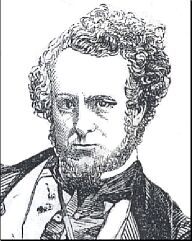Howard Staunton

|
|
| Howard Staunton, around 1855 |
|
| Association |
|
| Born | April 1810 London |
| Died | London June 22, 1874 |
| Best Elo rating | 2706 (November 1846) ( historical rating ) |
Howard Staunton (born April 1810 in London ; † June 22, 1874 ibid) was an important British chess player , chess journalist and Shakespeare researcher. Between 1843 and 1851 he was considered the strongest chess player in the world.
Life
Born the illegitimate son of the Count of Carlisle , Staunton grew up in poor circumstances and did not learn to play chess until he was 20, relatively late for a great chess master. It was not until 1830 that he appeared in the London chess clubs. Before that he was active as an actor and performed a. a. with the great actor Edmund Kean in William Shakespeare's The Merchant of Venice , in which he was able to assert himself in the role as Lorenzo alongside Kean's Shylock . In addition, Staunton occupied himself for years with the works of Shakespeare and also worked as the editor of a work edition published monthly from November 1857 to May 1860 and illustrated by John Gilbert . He also wrote a work on English education in 1865 entitled The great schools of England .
Staunton studied opening theory extensively , which accelerated his considerable success on the chessboard. He became a brilliant analyst and in his honor the Ponziani opening , which he had studied thoroughly, was given the designation English opening , which designation was later transferred to the opening move 1. c2 – c4. A variant of the Dutch defense , the Staunton Gambit , also got its name .
Staunton quickly became one of the best chess players in Europe. In 1843 he challenged the French master Pierre Saint Amant to a competition in the famous Parisian chess café Café de la Régence . Out of 21 games, he won eleven, lost six and drew four times. After that he was considered the strongest player in the world.
From 1841 Staunton published the chess newspaper "The Chess Player's Chronicle" and managed it until 1852. It was the second chess newspaper ever after the French magazine " Le Palamède ". He often presented his own games here, with winning games being overrepresented. But he also published one of the most famous chess problems there, the Indian problem . From 1845 until his death Staunton also wrote the chess section in the "Illustrated London News". Here he reported on the developing chess life around the world and published chess problems and games. This chess section is now considered a valuable source of information. He also published several chess books, including his influential textbook, The Chess-Player's Handbook , in 1847 . The form of chess pieces ( Staunton pieces ) recommended by him is used today in almost all official tournaments.
In February 1849 he married the widowed Frances Carpenter, who was several years older than him. At the age of 64, Staunton died of a heart attack in his home library . He was buried in Kensal Green Cemetery .
Merits
Staunton also achieved great merits because, due to his efforts, the first major international chess tournament took place in London at the same time as the World Exhibition in 1851 . He asked chess friends in England and the colonies for donations and thus provided the financial basis for the tournament . The organizing committee consisted of leading figures from London society. The affluent chess club St. George sent invitations to the leading chess masters in Europe. The tournament finally had sixteen participants, including Adolf Anderssen and Lionel Kieseritzky . Staunton, previously a favorite, lost to Anderssen, who unexpectedly won the tournament. Staunton was only fourth. Thinking times of 12 to 16 hours per game were common in this tournament, as there was still no chess clock and no time limit.
Staunton couldn't cope with the failure. In his magazine he belittled his opponents and cited an alleged illness as an excuse. In 1853 Staunton lost an unofficial match against von der Lasa and then withdrew from the international chess scene. When the new rising star in chess, Paul Morphy from the USA, asked him to compete in 1858, he avoided a duel. His best historical Elo rating was 2706. This he achieved in November 1846. He was number one in the world rankings for more than six years.
Works
- Digital view of the years of The Chess Player's Chronicle
- The Chess-player's Handbook: A Popular and Scientific Introduction to the Game of Chess . London 1847 (several editions).
- The Chess Player's Companion . London 1849
- The Chess Tournament . London 1852
- Chess Practice: A Supplement to the Chess Player's Handbook . London 1860
literature
- Carl Meier (Ed.): The chess fight in Paris, November and December 1843, between Mr. Staunton and M. de St.-Amant , Zurich 1844.
- Raymond Keene , Richard N. Coles: Howard Staunton, the English world chess champion. The British Chess Magazine, St. Leonards on Sea 1975, ISBN 0-900846-19-4 .
- Bernd-Peter Lange: Modernization of the aristocratic habitus. Howard Staunton as a Victorian gentleman, chess master and philologist. In: Archives for cultural history . Vol. 76 (1994), H. 1, pp. 201-229, doi: 10.7788 / akg.1994.76.1.201 .
- Mario Ziegler: The Chess Tournament London 1851. ChessCoach, St. Ingbert 2013, ISBN 978-3-944158-00-6 , pp. 107-124.
Web links
- Replayable chess games by Howard Staunton on chessgames.com (English)
Individual evidence
- ↑ Deutsche Schachzeitung, Volume 1874, p. 121.
| personal data | |
|---|---|
| SURNAME | Staunton, Howard |
| BRIEF DESCRIPTION | British chess player, chess journalist and Shakespeare researcher |
| DATE OF BIRTH | April 1810 |
| PLACE OF BIRTH | London |
| DATE OF DEATH | June 22, 1874 |
| Place of death | London |

